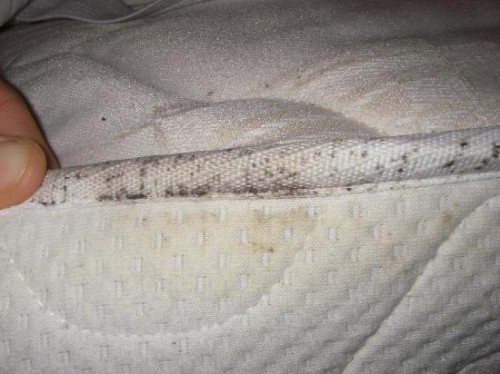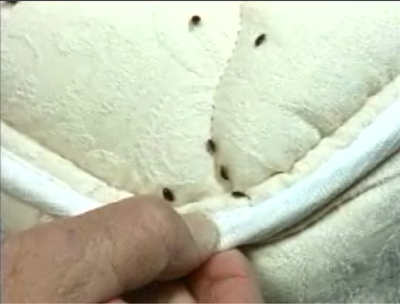A public service post. Mostly it’s for me and my friends/family, a one-stop shopping for quick bed bug info.
If you haven’t heard, bed bugs are making a comeback. Before WW II they were common. Then they were largely eradicated in the U.S. by the use of DDT. Now they’re showing up lots of places, including hotel rooms. Since I’m about to do some traveling, I thought I should learn how to spot a bed bug problem. The last thing I want to do is pick up bed bugs in a hotel room and bring them back to my house.
I listened recently to Terry Gross’s Fresh Air interview with Michael Potter, a bed bug expert. Here’s how he checks a hotel room for bed bugs:
First thing I do before I unpack is I remove the bed sheets and the blankets and I examine the upper and lower seams of the mattress at the two corners by the pillow area and along the seam that runs along the headboard. The reason I look there first is because bedbugs tend to be drawn to heat and carbon dioxide as a person sleeps so if they’re on the mattress, you’re more likely to see them in that location. … If I can see the upper seam of the box spring, I’ll take a look at that as well, looking for the little brown bugs themselves as well as the black speckling which are the droppings of the bedbugs.
If he finds evidence of bed bugs, he gets another room (infestations tend to be local, many rooms can be fine even if one is not). Even still, he’s very cautious:
It is probable that if you have a very low-level infestation of bed bugs in that hotel room, you will not see them. … I tend to use what I need and zip up my suitcase. I tend to leave my suitcase on as hard of a surface as I can find like a tabletop or credenza or on a luggage rack rather than laying it on the floor instead of on the other bed.
The MSNBC site has a step-by-step list of how to search for bed bugs. They pretty much echo what Potter said:
Peel back the bedsheets and check the mattress, running your fingers along the upper and lower seams. Make sure to check the mattress tag, bed bugs often hide there.
Experts recommend removing and examining the headboard if possible. Check for tiny black spots (excrement) that are smaller than poppy seeds. You may also see translucent light brown skins or, in the case of an infestation— live bugs. [Note to self: bring a flashlight to peek behind the headboard if removal is impossible.]
Check the bedside table. Look for signs of bed bugs in the drawers and along the wall on the side of the bed that is less likely to be disturbed by cleaning staff and guests.
You may want to elevate suitcases and keep them off the floor, like on a luggage stand. […]
If bed bugs are detected, travelers should request for another room. […]
When you pack to leave, inspect your luggage carefully first, and inspect every item as you pack to help detect any bugs or their signs. Laundering most cloth items with typical hot water and detergent followed by drying on low heat for at least 20 minutes (or standard dry cleaning) should kill all bed bugs in or on such items. Sealing freshly-laundered items inside a plastic bag should help keep any more bed bugs from getting in those items later to hide (and be carried back with you).
Just so I (and you) know what to look for, here are some images (way more on Google Images):
There’s no need to get all worked up about this. Just take a few minutes to check your hotel room or any other room (got or rent a vacation home used by many people? Check it!). If you suspect a problem, do something about it. You don’t want to risk bringing the bugs home. De-bugging your home is something you want to avoid. It’s not that easy and it’s costly and disruptive.




